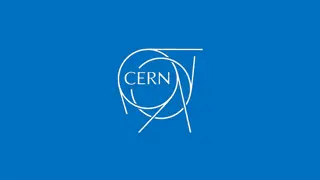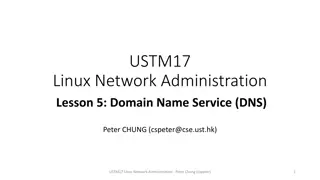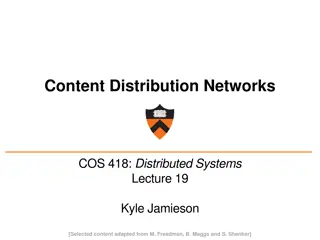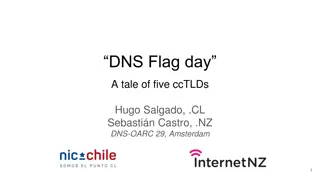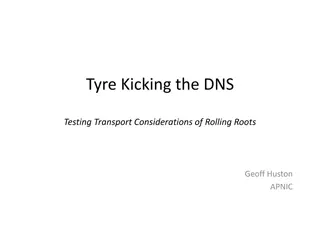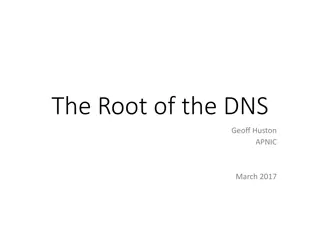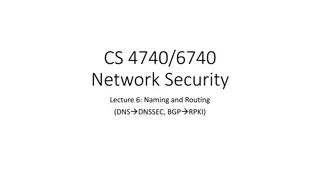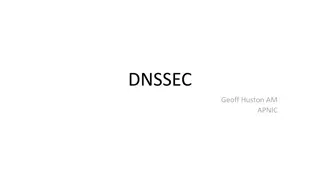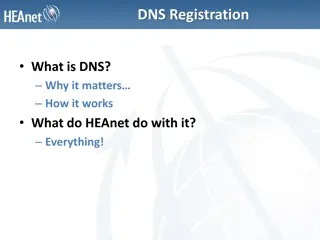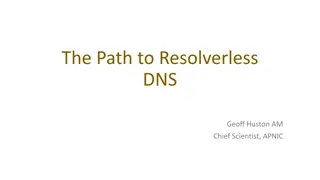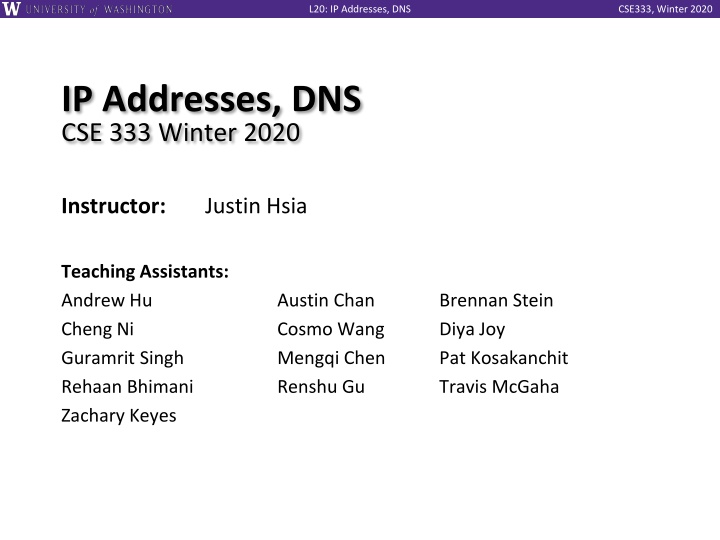
L20 IP Addresses DNS CSE333 Winter 2020 Lecture Overview
Discover the fundamentals of IP addresses, DNS, network programming, sockets, file descriptors, and more in the CSE333 Winter 2020 lecture series. Gain insights into network communications and file I/O operations, as well as understanding file descriptor tables and UNIX network I/O functionalities.
Download Presentation

Please find below an Image/Link to download the presentation.
The content on the website is provided AS IS for your information and personal use only. It may not be sold, licensed, or shared on other websites without obtaining consent from the author. If you encounter any issues during the download, it is possible that the publisher has removed the file from their server.
You are allowed to download the files provided on this website for personal or commercial use, subject to the condition that they are used lawfully. All files are the property of their respective owners.
The content on the website is provided AS IS for your information and personal use only. It may not be sold, licensed, or shared on other websites without obtaining consent from the author.
E N D
Presentation Transcript
L20: IP Addresses, DNS CSE333, Winter 2020 IP Addresses, DNS CSE 333 Winter 2020 Instructor: Justin Hsia Teaching Assistants: Andrew Hu Cheng Ni Guramrit Singh Rehaan Bhimani Zachary Keyes Austin Chan Cosmo Wang Mengqi Chen Renshu Gu Brennan Stein Diya Joy Pat Kosakanchit Travis McGaha
L20: IP Addresses, DNS CSE333, Winter 2020 Administrivia hw3 is due Thursday (2/27) Usual reminders: don t forget to tag, clone elsewhere, and recompile hw4 out on Friday (2/28) Exercise 15 will be released on Thursday Related to section this week Can start looking at it early; we ll finish covering material on Friday 2
L20: IP Addresses, DNS CSE333, Winter 2020 Lecture Outline Network Programming Sockets API Network Addresses DNS Lookup 3
L20: IP Addresses, DNS CSE333, Winter 2020 Files and File Descriptors Remember open(), read(), write(), and close()? POSIX system calls for interacting with files open() returns a file descriptor An integer that represents an open file This file descriptor is then passed to read(), write(), and close() Inside the OS, the file descriptor is used to index into a table that keeps track of any OS-level state associated with the file, such as the file position 4
L20: IP Addresses, DNS CSE333, Winter 2020 Networks and Sockets UNIX likes to make all I/O look like file I/O You use read() and write() to communicate with remote computers over the network! A file descriptor use for network communications is called a socket Just like with files: Your program can have multiple network channels open at once You need to pass a file descriptor to read() and write() to let the OS know which network channel to use 5
L20: IP Addresses, DNS CSE333, Winter 2020 File Descriptor Table OS s File Descriptor Table for the Process File 128.95.4.33 Type Connection Descriptor Web Server 0 pipe stdin (console) fd 5 fd 8 fd 9 fd 3 1 pipe stdout (console) 2 pipe stderr (console) TCP socket local: 128.95.4.33:80 remote: 44.1.19.32:7113 3 index.html pic.png 5 file index.html 8 file pic.png TCP socket local: 128.95.4.33:80 remote: 102.12.3.4:5544 9 client client 6
L20: IP Addresses, DNS CSE333, Winter 2020 Types of Sockets Stream sockets For connection-oriented, point-to-point, reliable byte streams Using TCP, SCTP, or other stream transports Datagram sockets For connection-less, one-to-many, unreliable packets Using UDP or other packet transports Raw sockets For layer-3 communication (raw IP packet manipulation) 7
L20: IP Addresses, DNS CSE333, Winter 2020 Stream Sockets Typically used for client-server communications Client: An application that establishes a connection to a server Server: An application that receives connections from clients Can also be used for other forms of communication like peer-to- peer 1) Establish connection: client server 2) Communicate: client server 3) Close connection: client server 8
L20: IP Addresses, DNS CSE333, Winter 2020 Datagram Sockets Often used as a building block No flow control, ordering, or reliability, so used less frequently e.g. streaming media applications or DNS lookups host 1) Create sockets: host host host host 2) Communicate: host host host 9
L20: IP Addresses, DNS CSE333, Winter 2020 The Sockets API Berkeley sockets originated in 4.2BSD Unix (1983) It is the standard API for network programming Available on most OSs Written in C POSIX Socket API A slight update of the Berkeley sockets API A few functions were deprecated or replaced Better support for multi-threading was added 10
L20: IP Addresses, DNS CSE333, Winter 2020 Socket API: Client TCP Connection We ll start by looking at the API from the point of view of a client connecting to a server over TCP There are five steps: 1) Figure out the IP address and port to which to connect 2) Create a socket 3) Connect the socket to the remote server 4) .read() and write() data using the socket 5) Close the socket 11
L20: IP Addresses, DNS CSE333, Winter 2020 Step 1: Figure Out IP Address and Port Several parts: Network addresses Data structures for address info DNS (Domain Name System) finding IP addresses 12
L20: IP Addresses, DNS CSE333, Winter 2020 IPv4 Network Addresses An IPv4 address is a 4-byte tuple For humans, written in dotted-decimal notation e.g. 128.95.4.1 (80:5f:04:01 in hex) IPv4 address exhaustion There are 232 4.3 billion IPv4 addresses There are 7.77 billion people in the world (February 2020) 13
L20: IP Addresses, DNS CSE333, Winter 2020 IPv6 Network Addresses An IPv6 address is a 16-byte tuple Typically written in hextets (groups of 4 hex digits) Can omit leading zeros in hextets Double-colon replaces consecutive sections of zeros e.g.2d01:0db8:f188:0000:0000:0000:0000:1f33 Shorthand: 2d01:db8:f188::1f33 Transition is still ongoing IPv4-mapped IPv6 addresses 128.95.4.1 mapped to ::ffff:128.95.4.1 or ::ffff:805f:401 This unfortunately makes network programming more of a headache 14
L20: IP Addresses, DNS CSE333, Winter 2020 Linux Socket Addresses Structures, constants, and helper functions available in #include <arpa/inet.h> Addresses stored in network byte order (big endian) Converting between host and network byte orders: uint32_t htonl(uint32_t hostlong); uint32_t ntohl(uint32_t netlong); h for host byte order and n for network byte order Also versions with s for short (uint16_t instead) How to handle both IPv4 and IPv6? Use C structs for each, but make them somewhat similar Use defined constants to differentiate when to use each: AF_INET for IPv4 and AF_INET6 for IPv6 15
L20: IP Addresses, DNS CSE333, Winter 2020 IPv4 Address Structures // IPv4 4-byte address struct in_addr { uint32_t s_addr; // Address in network byte order }; // An IPv4-specific address structure struct sockaddr_in { sa_family_t sin_family; // Address family: AF_INET in_port_t sin_port; // Port in network byte order struct in_addr sin_addr; // IPv4 address unsigned char sin_zero[8]; // Pad out to 16 bytes }; struct sockaddr_in: family port addr zero 0 2 4 8 16 16
L20: IP Addresses, DNS CSE333, Winter 2020 Practice Question Assume we have a struct sockaddr_in that represents a socket connected to 198.35.26.96 (c6:23:1a:60) on port 80 (0x50) stored on a little-endian machine. AF_INET = 2 Fill in the bytes in memory below (in hex): 0 8 17
L20: IP Addresses, DNS CSE333, Winter 2020 IPv6 Address Structures // IPv6 16-byte address struct in6_addr { uint8_t s6_addr[16]; // Address in network byte order }; // An IPv6-specific address structure struct sockaddr_in6 { sa_family_t sin6_family; // Address family: AF_INET6 in_port_t sin6_port; // Port number uint32_t sin6_flowinfo; // IPv6 flow information struct in6_addr sin6_addr; // IPv6 address uint32_t sin6_scope_id; // Scope ID }; struct sockaddr_in6: addr fam port flow scope 0 2 4 8 24 28 18
L20: IP Addresses, DNS CSE333, Winter 2020 Generic Address Structures // A mostly-protocol-independent address structure. // Pointer to this is parameter type for socket system calls. struct sockaddr { sa_family_t sa_family; // Address family (AF_* constants) char sa_data[14]; // Socket address (size varies // according to socket domain) }; // A structure big enough to hold either IPv4 or IPv6 structs struct sockaddr_storage { sa_family_t ss_family; // Address family // padding and alignment; don t worry about the details char __ss_pad1[_SS_PAD1SIZE]; int64_t __ss_align; char __ss_pad2[_SS_PAD2SIZE]; }; Commonly create struct sockaddr_storage, then pass pointer cast as struct sockaddr* to connect() 19
L20: IP Addresses, DNS CSE333, Winter 2020 Address Conversion int inet_pton(int af, const char* src, void* dst); Converts human-readable string representation ( presentation ) to network byte ordered address Returns 1 (success), 0 (bad src), or -1 (error) int inet_pton(int af, const char* src, void* dst); #include <stdlib.h> #include <arpa/inet.h> genaddr.cc int main(int argc, char **argv) { struct sockaddr_in sa; // IPv4 struct sockaddr_in6 sa6; // IPv6 // IPv4 string to sockaddr_in (192.0.2.1 = C0:00:02:01). inet_pton(AF_INET, "192.0.2.1", &(sa.sin_addr)); // IPv6 string to sockaddr_in6. inet_pton(AF_INET6, "2001:db8:63b3:1::3490", &(sa6.sin6_addr)); return EXIT_SUCCESS; } 20
L20: IP Addresses, DNS CSE333, Winter 2020 Address Conversion int inet_pton(int af, const char* src, void* dst); const char* inet_ntop(int af, const void* src, char* dst, socklen_t size); Converts network addr in src into buffer dst of size size Returns dst on success; NULL on error #include <stdlib.h> #include <arpa/inet.h> genstring.cc int main(int argc, char **argv) { struct sockaddr_in6 sa6; // IPv6 char astring[INET6_ADDRSTRLEN]; // IPv6 // IPv6 string to sockaddr_in6. inet_pton(AF_INET6, "2001:0db8:63b3:1::3490", &(sa6.sin6_addr)); // sockaddr_in6 to IPv6 string. inet_ntop(AF_INET6, &(sa6.sin6_addr), astring, INET6_ADDRSTRLEN); std::cout << astring << std::endl; return EXIT_SUCCESS; } 21
L20: IP Addresses, DNS CSE333, Winter 2020 Domain Name System People tend to use DNS names, not IP addresses The Sockets API lets you convert between the two It s a complicated process, though: A given DNS name can have many IP addresses Many different IP addresses can map to the same DNS name An IP address will reverse map into at most one DNS name A DNS lookup may require interacting with many DNS servers You can use the Linux program dig to explore DNS dig @server name type (+short) server: specific name server to query type: A (IPv4), AAAA (IPv6), ANY (includes all types) 22
L20: IP Addresses, DNS CSE333, Winter 2020 DNS Hierarchy Root Name Servers . Top-level Domain Servers com cn edu org facebook google netflix apache wikipedia fsf docs mail news www news www 23
L20: IP Addresses, DNS CSE333, Winter 2020 Resolving DNS Names The POSIX way is to use getaddrinfo() A complicated system call found in #include <netdb.h> Basic idea: int getaddrinfo(const char* hostname, const char* service, const struct addrinfo* hints, struct addrinfo** res); Tell getaddrinfo() which host and port you want resolved String representation for host: DNS name or IP address Set up a hints structure with constraints you want respected getaddrinfo() gives you a list of results packed into an addrinfo structure/linked list Returns 0 on success; returns negative number on failure Free the struct addrinfo later using freeaddrinfo() 24
L20: IP Addresses, DNS CSE333, Winter 2020 getaddrinfo getaddrinfo() arguments: hostname domain name or IP address string service port # (e.g."80") or service name (e.g."www") or NULL/nullptr struct addrinfo { int ai_flags; // additional flags int ai_family; // AF_INET, AF_INET6, AF_UNSPEC int ai_socktype; // SOCK_STREAM, SOCK_DGRAM, 0 int ai_protocol; // IPPROTO_TCP, IPPROTO_UDP, 0 size_t ai_addrlen; // length of socket addr in bytes struct sockaddr* ai_addr; // pointer to socket addr char* ai_canonname; // canonical name struct addrinfo* ai_next; // can form a linked list }; 25
L20: IP Addresses, DNS CSE333, Winter 2020 DNS Lookup Procedure struct addrinfo { int ai_flags; // additional flags int ai_family; // AF_INET, AF_INET6, AF_UNSPEC int ai_socktype; // SOCK_STREAM, SOCK_DGRAM, 0 int ai_protocol; // IPPROTO_TCP, IPPROTO_UDP, 0 size_t ai_addrlen; // length of socket addr in bytes struct sockaddr* ai_addr; // pointer to socket addr char* ai_canonname; // canonical name struct addrinfo* ai_next; // can form a linked list }; 1) Create a struct addrinfo hints 2) Zero out hintsfor defaults 3) Set specific fields of hints as desired 4) Call getaddrinfo() using &hints 5) Resulting linked list res will have all fields appropriately set See dnsresolve.cc 26

